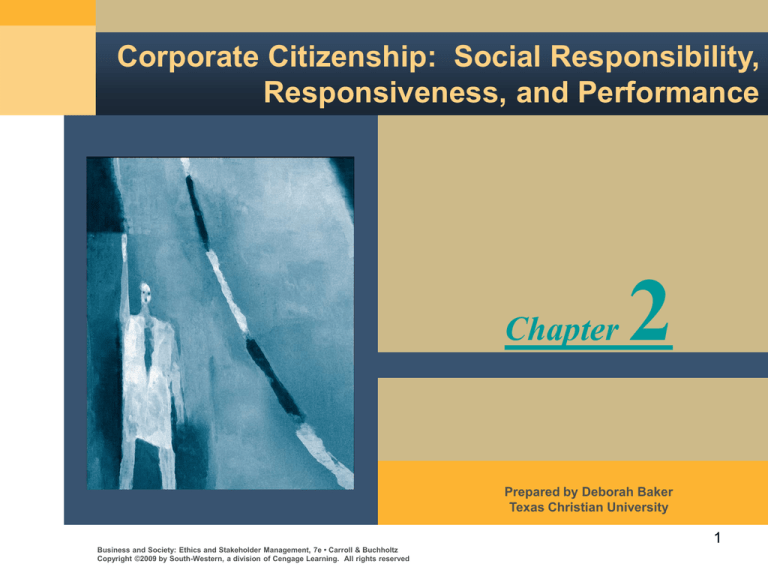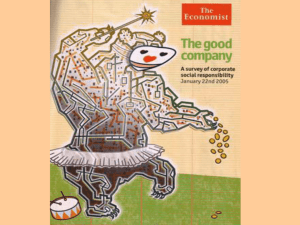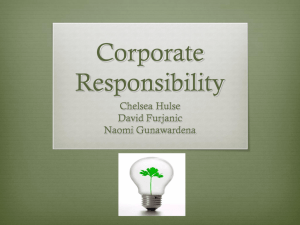
Corporate Citizenship: Social Responsibility,
Responsiveness, and Performance
Chapter
2
Prepared by Deborah Baker
Texas Christian University
Business and Society: Ethics and Stakeholder Management, 7e • Carroll & Buchholtz
Copyright ©2009 by South-Western, a division of Cengage Learning. All rights reserved
1
Chapter 2 Learning Outcomes
1. Explain how corporate social responsibility (CSR)
evolved and now encompasses economic, legal,
ethical, and philanthropic components.
2. Provide business examples of CSR and corporate
citizenship.
3. Differentiate between corporate citizenship, social
responsibility, responsiveness, and performance.
4. Elaborate on the concept of corporate social
performance (CSP).
2
Chapter 2 Learning Outcomes
5. Explain how corporate citizenship develops in stages
in companies.
6. Describe the socially responsible investing
movement.
3
Introduction to Chapter 2
Business allegations…
Little concern for the consumer
Cares nothing about the deteriorating social order
Has no concept of acceptable ethical behavior
Indifferent to the problems of minorities and the
environment
What responsibility does business have to society?
@
http://www.bsr.org
4
Corporate Social Responsibility (CSR)
Seriously considering the impact of
a company’s actions on society.
Corporate
Social
Responsibility
Requires the individual to consider
his/her acts in terms of a whole
social system, and holds him/her
responsible for the effects of acts
anywhere in that system.
5
Corporate Citizenship Concepts
Corporate Social…
Emphasizes…
Responsibility
Obligation, accountability
Responsiveness
action, activity
Performance
outcomes, results
6
Business Criticism/
Social Responsibility Cycle
Factors in the Societal Environment
(have led to)
Criticism of Business
Increased Concern
for the Social Environment
(which has resulted in)
A Changed
Social Contract
Business Assumption of
Corporate Social Responsibility
Social Responsiveness, Social
Performance, and Corporate Citizenship
A More Satisfied Society
Fewer Factors Leading to
Business Criticism
Figure 2-1
Increased Expectations7
Leading to More Criticism
Historical Perspective on CSR
Economic Model
Produce and services at a Fair Market price
“The Invisible hand of the Market”.
Legal Model
Rules and Laws business were
Expected to follow
Social Model
A stakeholder model
8
Modification of the Economic Model
Philanthropy
Community obligations
Paternalism
Motivation:
Keep government at arm’s length
9
Acceptance and Broadening of Meaning
From the 1950’s to the present, the concept of CSR has
gained considerable acceptance and the meaning has been
broadened to include specific issues, such as:
•
•
•
•
•
•
•
•
corporate governance
product safety
honesty in advertising
employee rights
affirmative action
environmental sustainability
ethical behavior
global CSR
10
CSR: Evolving Viewpoints
1. CSR considers the impact of the company’s actions
on society.
2. CSR requires decision makers to take actions that
protect and improve the welfare of society as a
whole along with their own interests.
11
CSR: Evolving Viewpoints
3. CSR supposes that the corporation has not only
economic and legal obligations, but also certain
responsibilities to society which extend beyond
these obligations.
12
CSR: Evolving Viewpoints
4. CSR relates primarily to achieving outcomes from
organizational decisions concerning specific
issues or problems which (by some normative
standard) have beneficial rather than adverse
effects upon pertinent corporate stakeholders. The
normative correctness of the products of corporate
action have been the main focus of CSR.
13
Carroll’s Four-Part Definition of CSR
Responsibility
Societal
Expectation
Examples
Economic
Required
Be profitable. Maximize sales,
minimize costs.
Legal
Required
Obey laws, adhere to
regulations
Ethical
Expected
Avoid questionable practices.
Do what is right, fair, and just
Philanthropic
Desired/
Expected
Be a good corporate citizen.
Give back.
Figure 2-2
14
Legal Responsibilities
Law cannot address all the topics or issues that
business may face
Law often lags behind more recent concepts of what
is considered appropriate behavior
Laws are made by lawmakers and may reflect the
personal interests/motivation of legislators rather
than appropriate ethical justifications
15
The Pyramid of CSR
Figure 2-3
16
The CSR Equation
Economic Responsibilities
+
Legal Responsibilities
+
Ethical Responsibilities
=
Total
Corporate
CSR
+
Philanthropic Responsibilities
For CSR Companies Go to
http://money.cnn.com/magazines/fortune/fortune_archive/2006/10/30/8391850/index.htm
17
Arguments Against CSR
Restricts the classic
economic goal of profit
maximization
Business is not
equipped to handle
social activities
Increases the power of
business
Limits the ability to
compete in a global
marketplace
Dilutes the primary
purpose of business
Arguments Against CSR
http://www.corporatewatch.org/?lid=2688
18
Arguments For CSR
Addresses social issues Addresses issues by
brought on by business,
and allows business to be
part of the solution
Protects business
using business resources
and expertise
Addresses issues by
being proactive
self-interest
Wards off future
The public supports CSR
government intervention
19
Ways Firms Respond to CSR Pressure
Defensive approach
Cost-benefit approach
Strategic approach
Innovation and learning approach
The Civil Corporation, Simon Zadek
20
Corporate Responsibility
in the 21st Century
Demonstrate a commitment to society’s values and
contribute to society’s social, environmental, and
economic goals through action.
Insulate society from the negative impacts of
company operations and its products and services.
Share benefits of company activities with key
stakeholders as well as with shareholders.
Demonstrate that the company can make more
money by doing the right thing.
21
Corporate Social Responsiveness
Responsibility
Responsiveness
Implies more of a state or
condition of having assumed
an obligation
Connotes a dynamic,
action-oriented condition
22
Corporate Social Responsiveness
Alternative Views
Sethi’s Three-Stage Schema
Frederick’s CSR1, CSR2, and CSR3
Epstein’s Process View
Figure 2-7
23
Corporate Social Performance:
Extensions, Reformulations, Reorientations
Wartick and Cochran’s CSP Extensions
Wood’s Reformulated CSP Model
Swanson’s Reorientation of CSP
Figure 2-9
24
Corporate Social Performance
Figure 2-10
25
Corporate Citizenship
Corporate Citizenship…
…embraces all the facets of corporate
social responsibility, responsiveness,
and performance.
…serves a variety of stakeholders.
26
Corporate Citizenship
A reflection of shared moral and ethical principles
A vehicle for integrating individuals into the
communities in which they work
A form of enlightened self-interest that balances
stakeholders’ claims and enhances a company’s
long-term value
Charles J. Fombrum, “Three Pillars of Corporate Citizenship”
27
Drivers of Corporate Citizenship
Internal Motivators
External Pressures
Traditions and values
Customers and consumers
Reputation and image
Expectations in the community
Business strategy
Laws and political pressures
Recruiting and retaining
employees
28
Benefits of Corporate Citizenship
Improved employee relations
Improved customer relationships
Improved business performance
Enhanced company’s marketing efforts
29
Stages of Corporate Citizenship
Figure 2-11
30
Development Challenges
of Corporate Citizenship
Figure 2-12
31
Business’s Interest in
Corporate Citizenship
Nonacademic Research
Fortune's ranking of “Most Admired” and
“Least Admired” corporations
Conference Board’s Ron Brown Award
for Corporate Leadership
CRO Magazine Awards
32
Social and Financial
Performance Relationship
Perspective 1: CSP Drives the Relationship
Good Corporate
Social Performance
Good Corporate
Financial
Performance
Good Corporate
Reputation
Perspective 2: CFP Drives the Relationship
Good Corporate
Financial
Performance
Good Corporate
Social Performance
Good Corporate
Reputation
Perspective 3: Interactive Relationship Among CSP, CFP, and CR
Good Corporate
Social Performance
Figure 2-13
Good Corporate
Financial
Performance
Good Corporate
Reputation
33
“Multiple Bottom Line” Perspective
Owner Stakeholders’
“Bottom Line”
Consumer Stakeholders’
“Bottom Line”
Corporate
Social
Performance
Employee Stakeholders’
“Bottom Line”
Community Stakeholders’
“Bottom Line”
Other Stakeholders’
“Bottom Line”
Figure 2-14
34
“Triple Bottom Line” Perspective
Key Spheres of Sustainability
1.
Economic
2.
Social
3.
Environmental
Is Sustainability Development the next new buzz word?
27,800,000 for sustainable development. Retrieved 1/13/2010
35
Socially Responsible
or Ethical Investing
Social
Screening
A technique used to screen
firms for socially-responsible
investment purposes
36
Reasons for Upsurge in
Socially Responsible Investing
1. More reliable research on CSP
2. Investment firms using social criteria have
solid track record
3. The socially conscious 1960s generation is
making investment decisions
37







